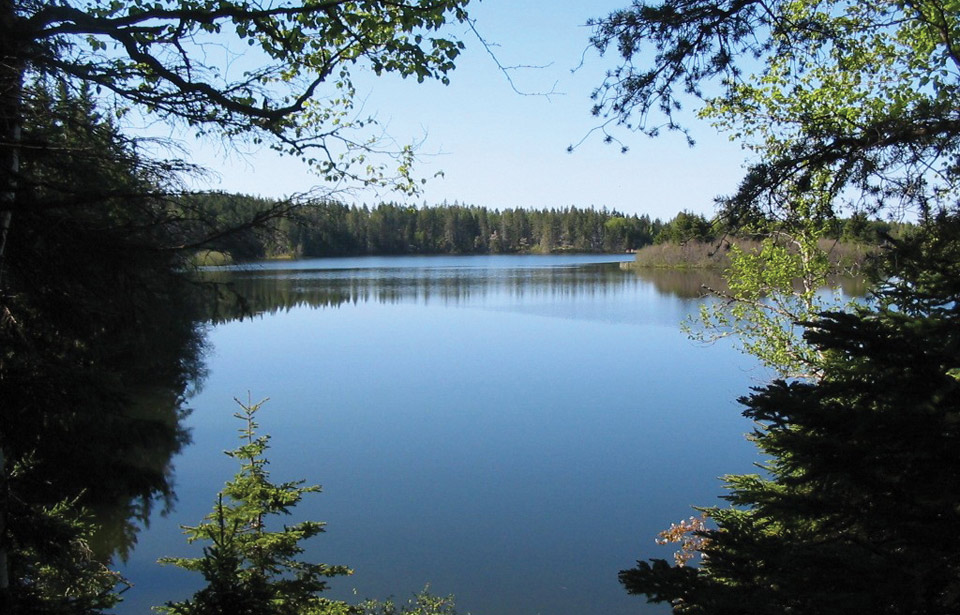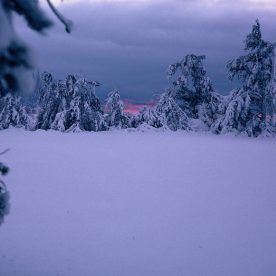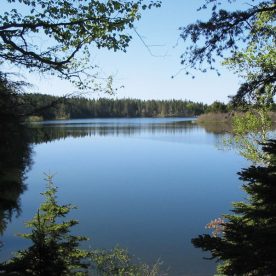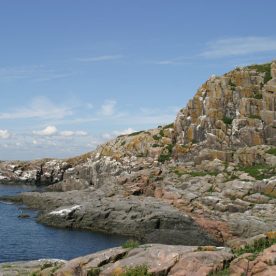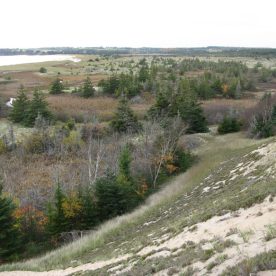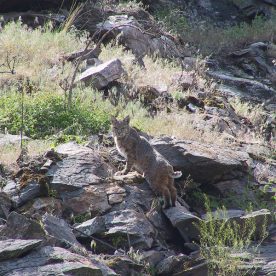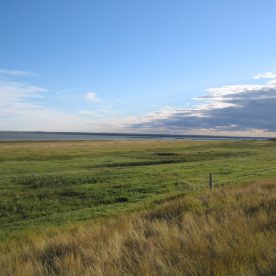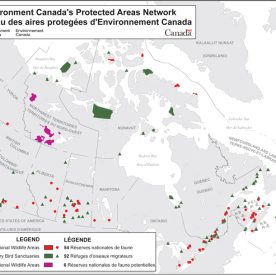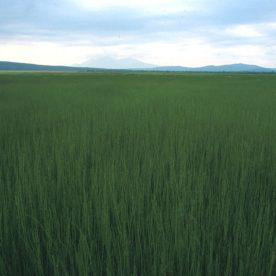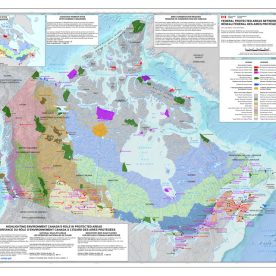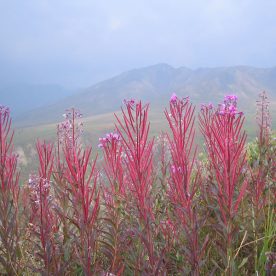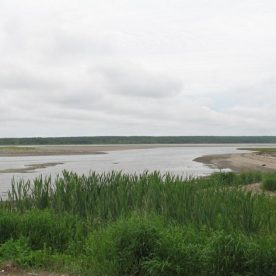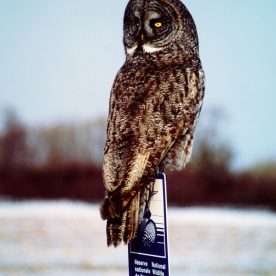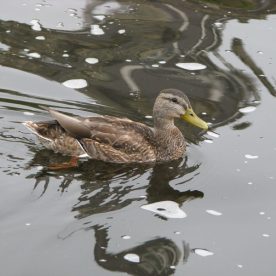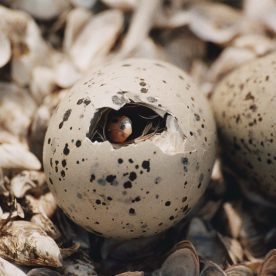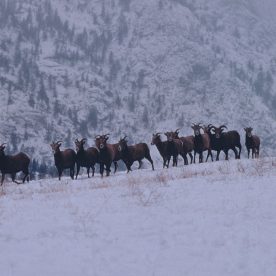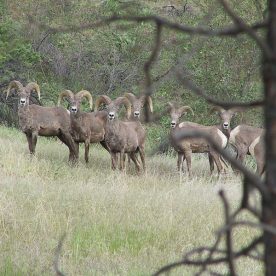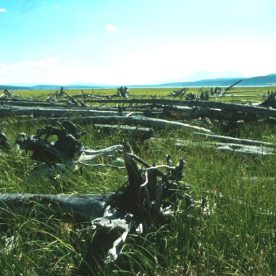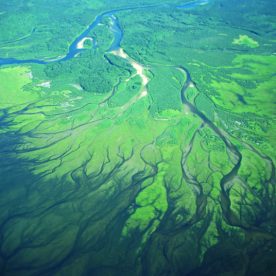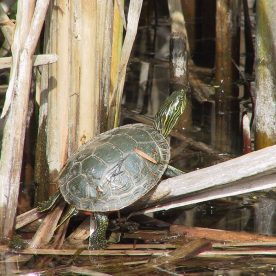Environment Canada’s Protected Areas Network
- includes the Queen Maud Gulf Migratory Bird Sanctuary in Nunavut, where over 90 percent of the world’s population of Ross’s Geese nest
- includes the wetlands and the agricultural and wooded uplands of the Alaksen National Wildlife Area in British Columbia, an internationally important migration stopover and wintering area for a huge number and variety of birds
- contains many areas that allow some public access
Why protected areas?
Why are some areas set aside for wildlife?
Canada is renowned as a land of magnificent natural scenery and a wealth of wildlife. What many people may not know, however, is that some of the country’s most important sites for wildlife and coincidentally, some of its most scenic sites, are protected spaces for wildlife.
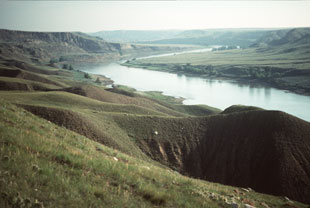
South Saskatchewan River Valley, Canadian Force Base (CFB)
Suffield National Wildlife Area, by Garry Trottier (CWS)
Canada is renowned as a land of magnificent natural scenery and a wealth of wildlife. What many people may not know, however, is that some of the country’s most important sites for wildlife and, coincidentally, some of its most scenic sites, are protected spaces for wildlife.
Environment Canada’s Canadian Wildlife Service administers a network of protected areas, which protects approximately 12.4 million hectares of wildlife habitat as of October 2010, an area more than twice the size of Nova Scotia. The most accurate statistics used for reporting on protected area are available on the Canadian Council on Ecological Areas web site at http://www.ccea.org/. The components of the network are National Wildlife Areas (NWAs) and Migratory Bird Sanctuaries (MBSs). These sites contain a wide diversity of habitat of national and international importance.
For example, approximately 75 percent of the world’s population of Semipalmated Sandpipers carpets the beaches and mudflats of Shepody National Wildlife Area in the Bay of Fundy over the six-to-eight-week southward migratory period each year. At some sites, single flocks can attain numbers of 250,000 birds or more and move as one body, wheeling in the sky, skimming over the water, and lighting on the shore in such density that the beaches seem alive with moving pebbles.
The Great Plain of the Koukdjuak on Baffin Island (part of which is protected as Dewey Soper Migratory Bird Sanctuary) shelters the largest goose colony in the world.
There are 54 NWAs and 92 MBSs as of October 2010. Some of these NWAs and MBSs extend beyond the shoreline, incorporating freshwater and marine areas, thereby helping to safeguard over 1.8 million hectares of Canada’s aquatic habitat. In addition, sites are being considered for designation as NWAs in offshore and coastal areas where plants, animals, and ecosystems need to be protected.
A marine National Wildlife Area: A first in Canada
The proposed National Wildlife Area around the Scott Islands archipelago in British Columbia will protect more than two million seabirds that nest there each year, including 55 percent of the world population of Cassin’s Auklets. The site is already an internationally recognized Important Bird Area.
Why have these areas been set aside? Each wild plant and animal species needs habitat—a particular location with specific characteristics, including an appropriate climate and available food and shelter, where wildlife may live. Animals that migrate, such as caribou, monarch butterflies, and many birds, need several habitats. They may breed in one habitat during summer, winter in another, and cross a number of other habitats as they undertake seasonal migrations.
To preserve abundant and diverse wildlife populations in Canada, we need to ensure suitable habitats exist. This is the purpose of Environment Canada’s protected areas. The Canadian Wildlife Service identifies wildlife habitat of national ecological importance whose loss would have a direct impact on the Canadian population of one or more wild species, and it works closely with many groups to ensure that such areas are protected as NWAs and MBSs.
How are areas established?
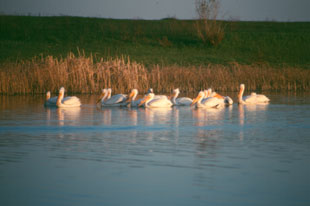
Pelicans, Last Mountain Lake National Wildlife Area,
by John Dunlop (CWS)
How are protected areas established?
North America’s oldest waterfowl sanctuary at Last Mountain Lake in Saskatchewan was set aside by Parliament in 1887 to protect breeding grounds for “Wild Fowl.” In 1916, Canada and the United States signed the Migratory Birds Convention which obliged both countries to preserve migratory birds and protect them from indiscriminate slaughter. Canada implemented the convention through the Migratory Birds Convention Act of 1917 under which Last Mountain Lake became an MBS.
The Migratory Birds Convention Act and the MBSs established under that act protect migratory birds against physical disturbance and hunting, which was the main threat in the early part of the century, but they do not protect habitat or species of wildlife other than migratory birds. By the 1960s and 1970s, significant wildlife habitats, particularly wetlands, were being lost at an alarming rate. The Canada Wildlife Act (1973) was passed to authorize the establishment of sites known as National Wildlife Areas in which migratory birds and other wildlife, particularly species at risk and most importantly, their habitat, could receive protection. In 1994, the act was amended to allow for the protection of marine areas as well.
The Species at Risk Act (SARA), which was proclaimed in 2003, expands the scope for applying NWA and MWA status to protect wildlife habitat. SARA aims to protect species recognized as being at risk nationally or regionally, as well as their habitat. SARA also amends the Canada Wildlife Act to allow the Minister of the Environment to give other federal ministers the power to name and manage NWAs.
Usually, CWS staff nominate a potential protected area, although members of the scientific community, provincial biologists, conservation groups, Aboriginal groups, and private citizens have all made proposals that have been adopted.
Canadian Forces Base Suffield National Wildlife Area
The Minister of Defence manages as an NWA a section of the Canadian Forces Base Suffield training area in southern Alberta. This area, which contains sand dune and mixed prairie habitat, is home to 14 species at risk in Canada, including the Burrowing Owl and the Ferruginous Hawk.
To be considered for designation as an NWA, a site must contain “nationally significant” habitat for migratory birds, support wildlife or ecosystems at risk, or represent a rare or unusual wildlife habitat or biogeographic region. NWAs must be comprised of land or waters under federal jurisdiction. MBSs must regularly support at least 1 percent of a population of a migratory bird species or subspecies. They may be comprised of federal, provincial, and/or private lands. Because NWA and MBS sites are selected based on their ecological importance for wildlife populations, several sites may be located in one region, as they are in the St. Lawrence valley. Sites may also be added to or removed from the network as their importance for wildlife changes.
Once a site is identified, CWS staff map the proposed area and conduct an inventory of the wildlife. CWS must then either obtain the landowner’s agreement for the designation, in the case of an MBS, or establish federal title to the land or water for an NWA. Finally, the site is officially “scheduled” under either the Migratory Bird Sanctuary Regulations or the Wildlife Area Regulations. This is a legislative process that includes publication in the Canada Gazette.
Migratory Bird Sanctuaries
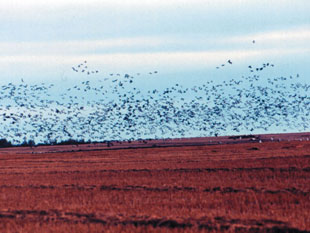
Geese and cranes, Last Mountain Lake National Wildlife Area,
by John Dunlop (CWS)
As of October 2010, MBSs cover approximately 11.4 million hectares. The largest federally designated area to protect migratory birds in Canada is the Queen Maud Gulf MBS, which was created in 1961 on the northern mainland tundra of Nunavut. Over 90 percent of the world’s population of a small white goose, called Ross’s Goose, nest there. The Queen Maud lowlands shelter the largest variety of geese of any nesting area in North America, including Ross’s Geese, Lesser Snow Geese, Canada Geese, White-fronted Geese, Atlantic Brant, and Black Brant, as well as Tundra Swans.
Migratory Bird Sanctuaries protect the habitat of thousands of birds
There are several very large MBSs in the Northwest Territories and Nunavut, but the sizes of the other MBSs vary greatly. In British Columbia, the Vaseaux Lake MBS, 282 hectares of lake and shoreline in the Okanagan Valley, was established to protect the endangered Trumpeter Swans that stop there during their autumn migration. Îles Sainte-Marie MBS (4 100 hectares) on the north shore of the Gulf of St. Lawrence is an important nesting site for thousands of seabirds, among them Common Murres and Razorbills.
The Migratory Bird Sanctuary Regulations prohibit disturbance of migratory birds, their eggs, and their nests within an MBS. The regulations also prohibit disturbance of migratory birds’ habitat when MBSs are established on federal Crown land. In most MBSs, visitors must not carry firearms or allow their pets to run at large. However, in northern Canada Aboriginal people have the right to carry firearms in MBSs for traditional hunting and trapping purposes.
Management includes monitoring wildlife, maintaining and improving wildlife habitat, periodic inspections, enforcement of hunting prohibitions and regulations, and the maintenance of signs. Research is also an important function of the protected areas; CWS staff carry out and coordinate research at some sites.
National Wildlife Areas
The purpose of NWAs is to conserve essential habitats for migratory birds and other wildlife species, especially endangered wildlife. As of October 2010, the NWAs protect just short of 1 million hectares of habitat.
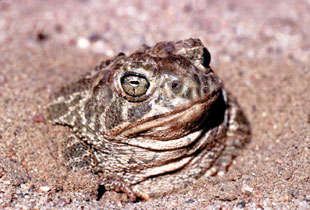
Great Plains toad, CFB Suffield National
Wildlife Area, by Garry Trottier (CWS)
National Wildlife Areas: Wildlands for Wildlife
NWAs protect a variety of important habitat areas across Canada. The wetlands and agricultural and wooded uplands of the Alaksen NWA in the Fraser River estuary in British Columbia are an internationally important migration stopover and wintering area for a huge number and variety of migrating birds, such as Lesser Snow Geese, ducks, and shorebirds. Pointe de l’Est NWA in the Gulf of St. Lawrence is one of the few remaining nesting sites in Quebec for the Piping Plover, which is an endangered species in Canada. The bowhead whales in the Ninginganiq NWA (Isabella Bay) on the east coast of Baffin Island are part of the endangered arctic population of bowheads.
CWS prepares a management plan for each NWA with the involvement of the local communities. The plan specifies activities that are generally allowed and identifies additional activities to be allowed under permit. For example, traditional uses such as berry picking, canoeing, hunting, fishing, and trapping may be generally allowed, while oil drilling, livestock grazing, or haying could be allowed with strict limitations under a yearly permit. Management plans may also specify how and where to make habitat improvements. Examples include planting native vegetation to provide food and cover and make the landscape more attractive to birds and other wildlife. Management plans must respect Aboriginal rights and practices specified under land claims agreements.
Under the Canada Wildlife Act, public education and research are also goals of NWAs. Although only some NWAs offer pportunities for public use, most NWAs don’t. In others, research and protection of sensitive natural resources take precedence. For example, access to Scotch Bonnet Island NWA in Lake Ontario is restricted because the island is used for long-term studies of the effects that environmental contamination of the Great Lakes is having on wild birds. All these education and research activities are regulated to prevent declines in wildlife populations and deterioration of habitats.
Aboriginal peoples and protected areas
The Canadian Wildlife Service is working with the Deh Cho and Tłichô First Nations to have the Edéhzhié area in the Northwest Territories — a 14,255 km² area that would be located on the plateau west of Great Slave Lake recognized by First Nations as a cultural and spiritual gathering place — legally designated as a protected area under the Canada Wildlife Act.
The Canada Wildlife Act can also be used to designate protected areas that would highlight the long-standing interaction of Aboriginal peoples with Canada’s natural spaces. The primary reason for establishing these areas would be the maintenance of their ecological value and biodiversity. The history of use and cultural value of these areas to Aboriginal peoples and the role that Aboriginal people would play in managing the areas would also be considerations.
International recognition
Many NWAs and MBSs have also been accorded international recognition. The Convention on Wetlands of International Importance, more commonly known as the Ramsar Convention, identifies and recognizes wetlands of international importance. Canada has 36 such sites, of which 17 are NWAs and MBSs.
The Western Hemisphere Shorebird Reserve Network links sites in different countries of North, Central, and South America that are essential to large numbers of shorebirds as they complete their yearly migrations of thousands of kilometres. Five sites are CWS protected areas.
The Important Bird Areas (IBA) Program is a global effort of BirdLife International to identify and protect the most critical habitats for the world’s birds. Of the 597 IBAs that have been identified in Canada as being of worldwide, continental, or national significance, 89 are located partially or wholly in NWAs or MBSs.
The international UNESCO biosphere reserve program aims to conserve biodiversity while taking human development into account. Four of the 12 biosphere reserves in Canada are part of CWS’s protected areas network.
Public Use
Wildlife conservation is the primary purpose of Environment Canada’s protected areas, with only some offering visitor facilities, and limited activities and services: Alaksen NWA in British Columbia; Cap Tourmente NWA in Quebec; St. Clair NWA in southwestern Ontario; Mary’s Point Unit of Shepody NWA, Cape Jourimain NWA, and Machias Seal Island MBS in New Brunswick; Chignecto NWA in Nova Scotia; and Last Mountain Lake NWA and MBS in Saskatchewan provide special facilities to view wildlife. In these protected areas, there may be exhibits, trails, brochures, and viewing stands to help visitors understand their surroundings. Locally published notices inform people about the activities that are generally permitted in protected areas, and people can consult the regional contacts provided at the end of this fact sheet to find out more about these activities. In some cases, special permits are required to engage in certain activities.
However, most NWAs and almost all MBSs are unstaffed and do not have on-site visitor services. In some cases, CWS may prohibit visitation during critical periods, such as nesting and moulting. For example, during the breeding season, the public may not visit Mohawk Island NWA in eastern Lake Erie. In New Brunswick, the activities of the tour boat operators who ferry birdwatchers to Machias Seal Island MBS are restricted by regulations that limit the number of visitors allowed on the island each day during the nesting period. Other NWAs and MBSs are closed to the public seasonally or permanently for a number of reasons, including geographical inaccessibility and wildlife preservation.
To find out more about Environment Canada protected areas, contact the nearest CWS regional office listed below or found on the Environment Canada Nature Web site at http://www.ec.gc.ca/ap-pa/. Acts and regulations related to protected areas are also located on the EC Web site.
For protected areas in Nova Scotia, New Brunswick, Newfoundland and Labrador, and Prince Edward Island:
Canadian Wildlife Service
Environment Canada
P.O. Box 6227
17 Waterfowl Lane
Sackville, New Brunswick E4L 1G6
Phone: (506) 364-5044
For sites in Quebec:
Canadian Wildlife Service
Environment Canada
1141, route de l’Église
C.P. 10 100
Sainte-Foy, Quebec G1V 4H5
Phone: (418) 648-7225
For sites in Ontario:
Canadian Wildlife Service
Environment Canada
P.O. Box 490
Lambeth Station
London, Ontario N6P 1R1
Phone: (519) 472-6695
For sites in Manitoba, Saskatchewan, Alberta, Nunavut, and the Northwest Territories:
Canadian Wildlife Service
Environment Canada
Room 200, 4999-98 Avenue
Edmonton, Alberta T6B 2X3
Phone: (780) 951-8700
For sites in British Columbia and Yukon:
Canadian Wildlife Service
Environment Canada
5421 Robertson Road, RR #1
Delta, British Columbia V4K 3N2
Phone: (604) 940-4700
Canadian Wildlife Service
Environment Canada
91782 Alaska Highway
Whitehorse, Yukon Y1A 5B7
Phone: (867) 393-6700
If you are interested in the nationwide system of Environment Canada protected areas, please contact:
Canadian Wildlife Service
Environment Canada
Ottawa, Ontario K1A 0H3
Phone: (819) 997-1095
E-mail: cws-scf@ec.gc.ca
Resources
Online resources
Environment Canada – Species at Risk
Print resources
Canadian Environmental Advisory Council. 1991. A protected areas vision for Canada. Ottawa.
Canadian Nature Federation. 2002. Conserving wildlife on a shoestring budget: Opportunities and challenges for Canada’s National Wildlife Areas, Migratory Bird Sanctuaries and Marine Wildlife Areas, Ottawa. (Available at the Canadian Nature Federation.)
Canadian Wildlife Service. 1996. Criteria for selecting candidate National Wildlife Areas. Revised edition. Ottawa.
Canadian Wildlife Service. 2002. Habitat Stewardship Program for species at risk. Ottawa. Available at www.cws-scf.ec.gc.ca/hsp-pih/default_e.cfm
Gillespie, D.I., H.Boyd, and P. Logan. 1991. Wetlands for the world: Canada’s Ramsar sites. Canadian Wildlife Service, Ottawa.
Wildlife Habitat Canada. 2001. The status of wildlife habitats in Canada 2001. Ottawa.
© Her Majesty the Queen in Right of Canada, represented by the Minister of the Environment, 1994, 2003
Catalogue no. CW69-4/90-2003E-IN
ISBN 0-662-34253-4
Text: S.P. Burns and C.L. Warren
Revision: 1996; S. Virc and A. Mailloux, 2003
Editing: M. Kavanagh, 2003
Photos: Garry Trottier and John Dunlop



